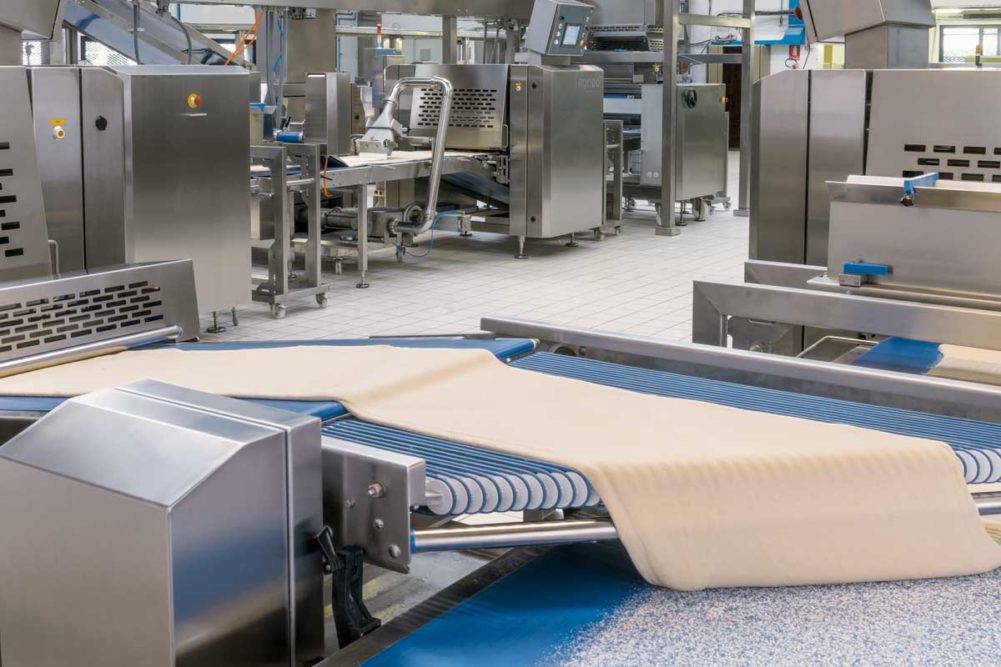While single-purpose lines are designed to crank out a high volume of baked goods, the inherent versatility of sheeting technology often encourages bakers to produce multiple items on one line.
To accommodate changeovers, Spooner Vicars, a Middleby Bakery company, relies on its latest A-PEX equipment to provide flexible, mechanical adjustments and integrated controls functionality, noted Andy Green, technical development manager.
“Incorporating the latest technologies enables full recipe control of speeds and roller-gap adjustments to ensure consistency of product and ease of operation for the operator,” he observed. “The advances in control PLCs, component devices and software have enabled full integration of equipment diagnostics interface with customers’ SCADA-type systems, enabling remote, consistent monitoring of all processes.
David Hamilton, sales director, Spooner Vicars, added that this data can be used to ensure product consistency when operating fully automated processes.
From a more mechanical perspective, Coen Nikkels, manager of marketing and business development, Rondo Industrial Solutions, pointed out that the company has made major advances in extrusion, cross-rolling, makeup and other tooling.
“Our MIDOS dough band former can handle stiff doughs as well as very soft doughs,” he said. “This serves the demand for flexible and multifunctional sheeting lines. The four independently driven rollers can be computer-controlled in speed and position to allow for a smooth and consistent, continuous dough band.”
Additionally, Mr. Nikkels said the combination of traditional and spiral cross rollers gently widens the dough band while automated makeup systems allow industrial bakers to create a variety of artisan baked goods.
For pastry producers, Fritsch offers the CBS Croissant Bending Robot, a servo-controlled bending unit that allows the production of diverse product shapes, including 4- to 7-inch fully circular croissants with minimal contact with the dough.
“The system maintains utmost positioning accuracy of the products using a camera that guides the bending tools individually to the true position of each dough piece on the belt,” observed Matt Zielsdorf, director of sales, Fritsch USA, a Multivac company. “This results in a reliable process and utmost shape and positioning accuracy of the bent products — even at a rate of up to 150 cycles per minute.”
At the 2019 International Baking Industry Exposition, Rheon USA introduced a vision system that monitors the tail position of curled croissants and automatically adjusts the machine settings to place the tail in the position desired.
John Giacoio, vice president of sales, Rheon USA, noted the vision system became a necessity after the company redesigned its croissant turning and curling section to form 200 pieces per minute per row — or 1,000 a minute on a five-row line.
“Controlling the tail position manually at this speed would have been impossible,” Mr. Giacoio said. “This is a great example of how one innovation leads to the need of another innovation. Sometimes you don't know you need something until you see it.”
When it comes to laminated baked goods, Mr. Nikkels pointed out that advances in fat pump technology allow bakers to add a consistent layer of different types of butter and margarine to the dough sheet before folding.
John McIsaac, vice president, strategic business development for Reiser, noted that its Vemag system provides precise metering of the fats — butter, margarine and shortening.
“In these applications, the Vemag is communicating with the line in order to apply the correct amount at whatever the line speed with no human intervention,” he said.
At its four Orange Bakery locations throughout North America, Rheon USA tests out new technology in a controlled environment. Such systems range from its stress-free dough handling process to flour dusting and reclamation systems, where the collected flour is sifted and recycled back to the line without human intervention.
David Moline, vice president of sales and marketing, Moline Machinery, observed that automatically filled flour dusting comes in handy when producing wetter or stickier doughs because the pneumatic delivery and externally sourced flour supply removes unnecessary labor from the line.
Additionally, installing something as simple as an inline checkweigher allows bakers to cut by weight, which is useful for creating higher volumes of ciabatta and other artisan breads.
This article is an excerpt from the August 2020 issue of Baking & Snack. To read the entire feature on sheeting and laminating, click here.





